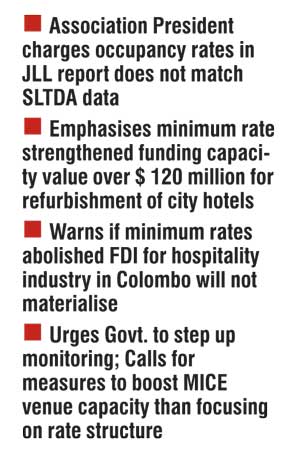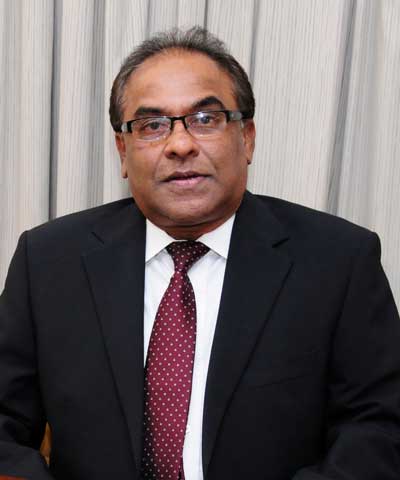Monday Dec 01, 2025
Monday Dec 01, 2025
Tuesday, 26 January 2016 00:00 - - {{hitsCtrl.values.hits}}

By Shehana Dain
City hoteliers are backing minimum room rate policy insisting that it has been highly beneficial and abandoning it would spell doom for leisure industry.
“Sri Lanka tourism has gained more positives than negatives from the minimum room rate policy,” Colombo City Hoteliers Association President M. Shanthikumar said in an apparent rejoinder to a recent Jones Lang LaSalle (JLL) report that sounded a warning against the move.
Professional services and investment management company specialising in real estate, JLL in its Sri Lanka hospitality sector report titled “Charting an Upward Momentum” said minimum rates have led to the drop in Colombo’s occupancy rates to 57% from 64% in 2012/13.
However Shanthikumar countered this point where city hotels are concerned, pointing out that some of the figures in the JLL report were incorrect signaling a wrong message to the public.
“We urge all parties to verify figures from the Sri Lanka Tourism Development Authority (SLTDA) prior to publishing, as incorrect figures will send wrong signals and will be detrimental to the future of the Tourism Industry in Sri Lanka. The occupancy figures stated in the report are incorrect. The average occupancy in Colombo across all categories of hotels for 2015 is overall 70% and not 57% as stated,” Shanthikumar emphasised.
“If the minimum rate implemented has had such a negative impact on increasing demand, we would like to ask the owners of this particular investor company, how Sri Lanka growth figures continued to record decent arrival growth figures over the past several years? It is a pity how even some professionals are of the opinion that the only way to drive demand is by reducing price. The present pricing in the Colombo City hotels is considered very reasonable by all hoteliers,” the Colombo City Hoteliers Chief said.
Colombo city has over 5500 quality accommodation units for sale in the formal sector, ranging from five star to one star rooms at price points from $ 125 to $ 50 excluding Government taxes, catering to different segments of the market at different price points.
Under the Government directive in 2009 which enforced a minimum rate five star rooms go at US$ 125 plus taxes (US$ 152), four  stars at US$ 95 plus tax (US$ 121), three stars at US$ 75 plus tax (US$ 95), two stars at US$ 55 plus tax (US$ 65)
stars at US$ 95 plus tax (US$ 121), three stars at US$ 75 plus tax (US$ 95), two stars at US$ 55 plus tax (US$ 65)
According to Shanthikumar the primary positive impact resulted from the execution of the minimum rate was financial stability across the board to carry out refurbishment operations.
“Since the implementation of the minimum rate to the Colombo city hotels, the revenue growth and profits in Colombo hotels have increased phenomenally. This resulted in most hotels reinvesting the earnings in the much needed renovation and refurbishment raising the hotels quality levels to International standards,” Shanthikumar said.
“For the first time the hoteliers did not request the Government for concessions. Over $ 120 million (Rs. 12 billion) was invested in these projects. We believe that return on investment cannot be only through increased occupancies but a model in which the occupancy is combined with the desired room rates,” he said.
Shanthikumar added that the Colombo hoteliers do not wish to base their business model only on increased occupancy rates in mind. “This will eventually get us back to average room rates of $ 55 to $ 65 in five star hotels. What will then happen to the other categories of hotels?,” queried Colombo City Hoteliers Chief.
He also highlighted that the minimum rate was a focal factor to attract foreign Investment for the hospitality industry in Colombo. “There is no doubt that the minimum room rates sent positive signals to potential investors such as international hotel chains looking at opportunities to open hotels in Colombo. It is common for these chains to meet existing hoteliers to understand market conditions and pricing before making any commitment to enter the country. If five star hotel rates were at $ 65 do you think chains such as the Shangri-la or the ITC group will ever enter the Sri Lankan market with such huge investments?” he opined.
Colombo hotels predominantly cater to the business traffic except during certain seasons when there is a growth in the leisure segment.
Shanthikuamr noted that rather than changing the rate structure which has benefited the investors, the Government and the employees, it is important to give suggestions and ideas to the Government of Sri Lanka to develop projects in Colombo to attract leisure traffic, especially to pull the ever-growing Indian and the Chinese market.
“We do agree that MICE is an important segment, but see that there is a huge challenge in terms of attracting large meetings and conferences to Sri Lanka due to the size constraints of the MICE venues. This is another key area to be addressed by the Government on an urgent basis,” he stressed.
Shanthikumar also urged the Government to step up monitoring of the implementation of the minimum room rate to ensure its fuller benefits.